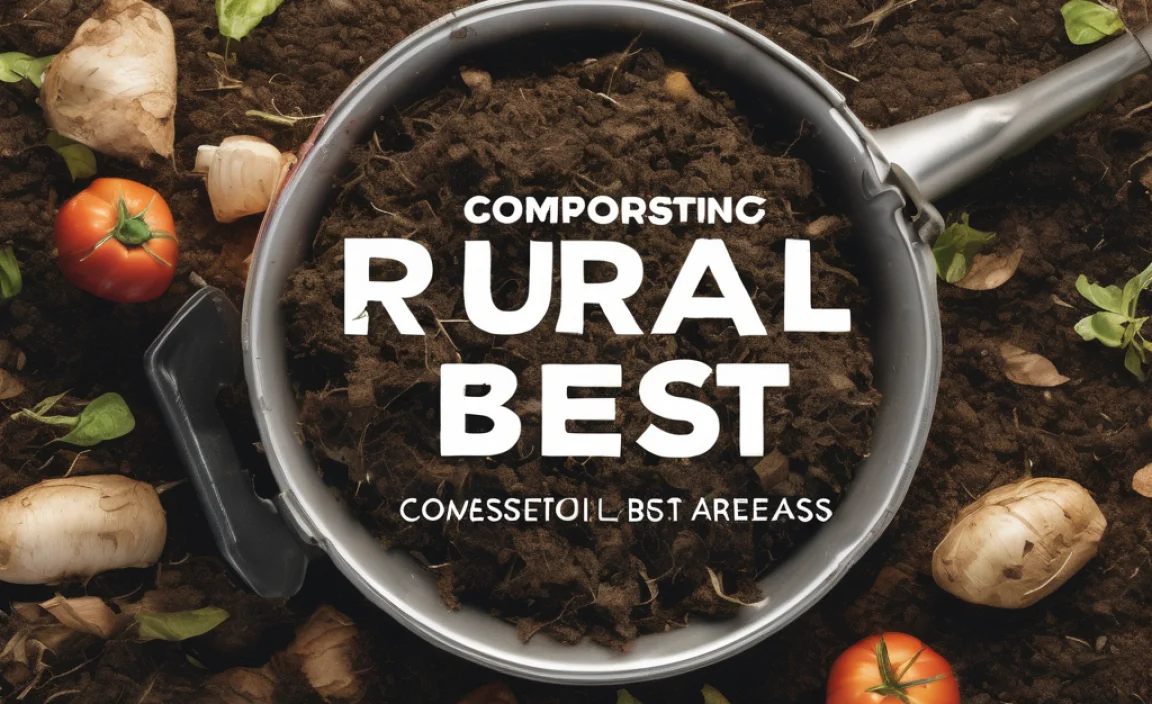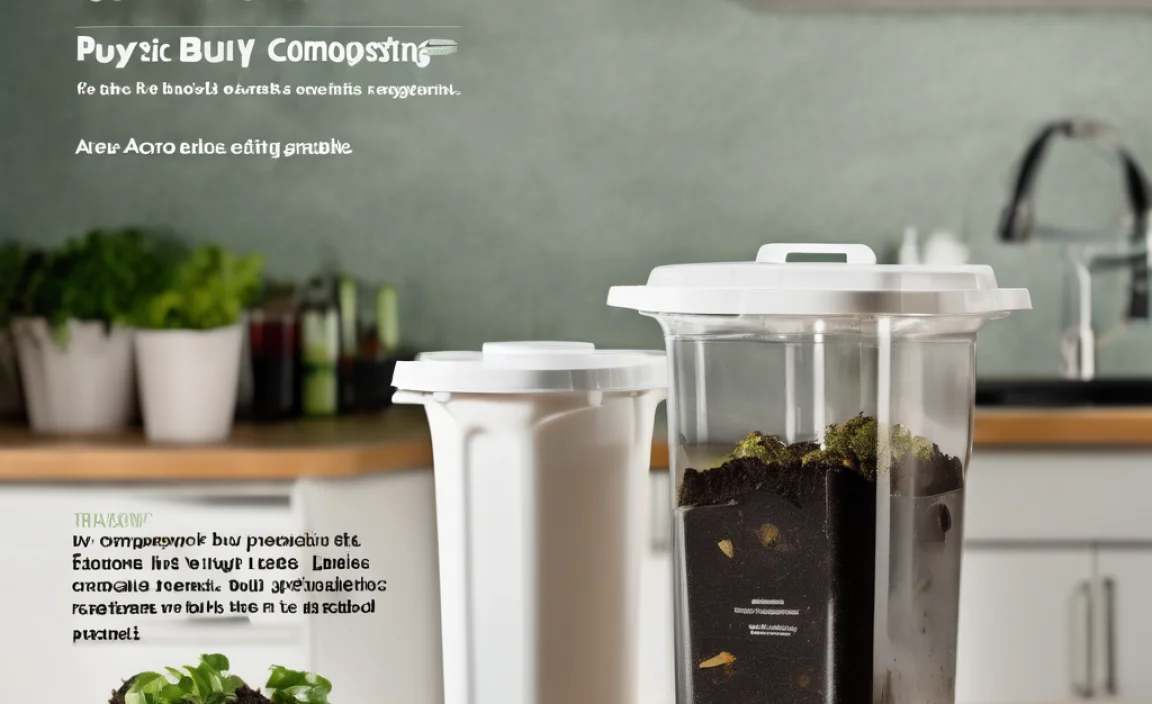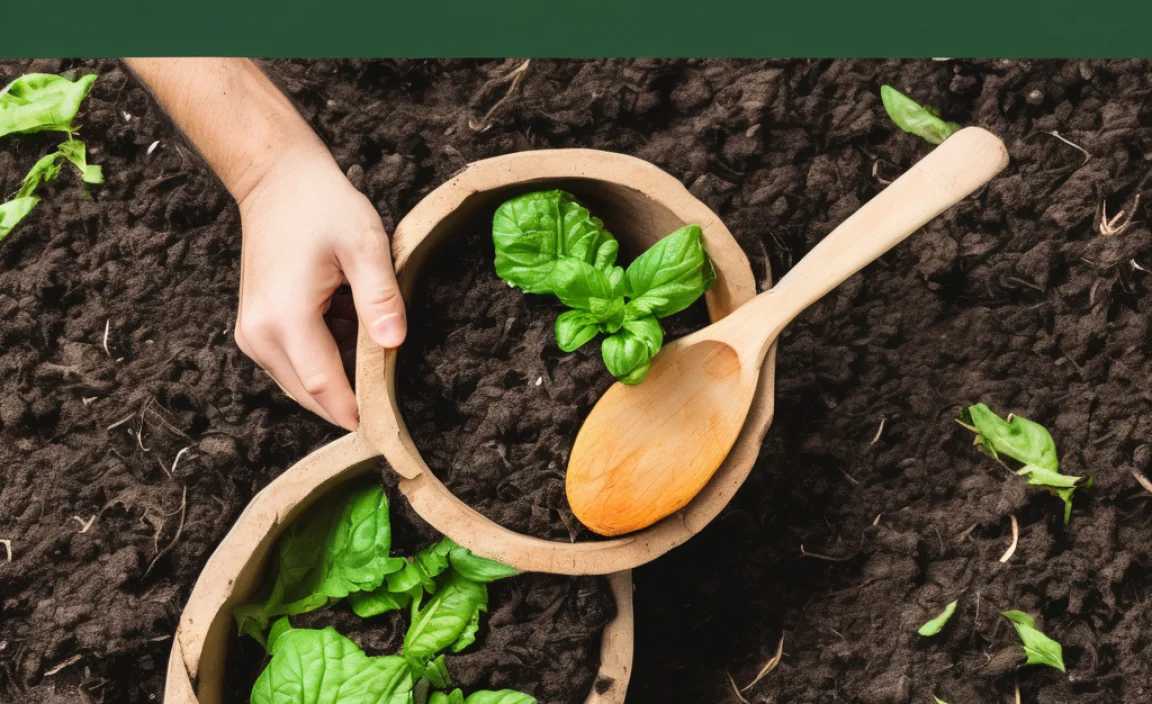Hey there, fellow home improvers and garden enthusiasts! Ever wondered about the difference between compost and humus? It can sound a bit confusing with all the gardening lingo out there, right? You’re trying to make your soil the best it can be, and these two terms pop up constantly. Don’t worry, I’m here to break it all down in a way that makes perfect sense. We’ll get you understanding exactly what they are and how they’ll help your plants thrive. Stick with me, and by the end of this, you’ll feel like a soil expert!
Compost vs Humus: What’s the Dirt? (And Why You Should Care!)
So, you’re looking at your garden soil, or maybe thinking about starting a compost bin, and you hear terms like “compost” and “humus.” They sound similar, and in a way, they are related, but knowing the difference can really boost your gardening game. Think of it like this: compost is the fresh ingredient, and humus is the incredibly mature, super-rich result. Both are fantastic for your soil, but they play different roles and come about in different ways. Understanding this “compost vs humus comparison” will help you make better decisions for healthier plants and happier soil.
We’ll dive into:
- What compost actually is and how it’s made.
- What humus is and why it’s so special.
- How they stack up against each other in terms of benefits.
- How you can use both to make your garden the envy of the neighborhood.
Let’s get digging!
What is Compost? Your Kitchen Scraps’ Second Life
Compost is essentially what happens when organic materials – think fruit peels, vegetable scraps, yard waste, and coffee grounds – decompose under controlled conditions. It’s a process that’s managed by you (or nature!) to speed up the breakdown of these materials into a nutrient-rich soil amendment. It’s like giving your kitchen scraps and yard waste a new life instead of sending them to the landfill.
Making compost is a hands-on activity. You’re actively managing living organisms – bacteria, fungi, and other microbes – to break down your organic “greens” (nitrogen-rich materials like food scraps) and “browns” (carbon-rich materials like dried leaves and cardboard). The goal is to create a balanced mix that these tiny helpers can work their magic on.
The Compost Recipe:
- Greens: Fruit and vegetable scraps, coffee grounds, tea bags, grass clippings, plant trimmings.
- Browns: Dried leaves, shredded newspaper, cardboard, twigs, straw, sawdust.
- Water: Keeps everything moist, but not soggy.
- Air: Helps the microbes breathe and speeds up decomposition.
When you compost correctly, you end up with a dark, crumbly material that smells earthy, not rotten. This finished compost is what you add to your garden soil to give it a nutrient boost and improve its structure.
Benefits of Compost:
- Adds valuable nutrients to the soil.
- Improves soil structure, making it easier to work with.
- Helps soil retain moisture, meaning you water less often.
- Encourages beneficial soil organisms.
- Reduces the need for synthetic fertilizers.
- Diverts waste from landfills.
Think of compost as the active, ready-to-use fertilizer and soil conditioner. It’s the builder, bringing immediate benefits and life to your garden beds.
What is Humus? The Gold Standard of Soil
Humus, on the other hand, is the end product of decomposition, but it’s much older and more stable than compost. It’s what you find in rich, natural topsoil, like that in ancient forests or well-established meadows. Humus is the dark, organic matter that has undergone a very long, slow natural decomposition process. It’s incredibly stable and can last in the soil for hundreds or even thousands of years.
Unlike compost, which is a result of a relatively quick, managed process, humus is formed over vast stretches of time through the breakdown of plant and animal material by microbes, fungi, and earthworms in the soil itself. It’s often described as the “black gold” of gardening because it’s so incredibly beneficial.
Key Characteristics of Humus:
- Highly Stable: It doesn’t break down easily, providing long-term soil improvement.
- Rich in Nutrients: It contains a wide array of plant nutrients in a form that is slowly released, feeding plants over extended periods.
- Exceptional Water Retention: Humus can hold many times its weight in water, acting like a sponge in the soil.
- Improved Soil Structure: It helps bind soil particles together, preventing compaction and improving aeration.
- Chelating Agent: It helps to hold essential minerals in the soil, preventing them from leaching away and making them available to plants.
Humus is not something you can “make” in a compost bin in a few weeks. You can add materials that will eventually become humus to your soil, and you can add compost, which is a stepping stone towards humus, but true humus is a product of nature’s patient work over long periods.
When you see deep, dark, loamy soil that feels wonderfully soft and holds moisture well, you’re looking at soil that is rich in humus. It’s the foundation of healthy ecosystems.
Compost vs Humus: The Big Comparison
Now that we know what each one is, let’s put compost and humus side-by-side. They both contribute to healthy soil, but they do it in different ways and at different stages of their “lifespan.”
| Feature | Compost | Humus |
|---|---|---|
| Origin | Managed, relatively rapid decomposition of organic matter. | Natural, slow, complex decomposition over very long periods. |
| Stability | Moderately stable; continues a slower breakdown process in soil. | Highly stable; resistant to further decomposition. |
| Nutrient Availability | Contains readily available nutrients and minerals. | Nutrients are often complexed and slowly released over time. |
| Microbial Activity | Rich in active microorganisms from the composting process. | Supports a diverse range of soil microorganisms. |
| Water Retention | Good; improves soil’s ability to hold water. | Excellent; capable of holding significantly more water than compost. |
| Soil Structure Improvement | Good; helps loosen compacted soils and improve aeration. | Excellent; binds soil particles, creating stable aggregates. |
| Timeframe to Produce | Weeks to months. | Centuries to millennia. |
| How We Get It | Actively made in a compost bin or pile. | Found in mature, healthy topsoil; enhanced by leaving organic matter to decompose naturally. |
As you can see, compost is your active contribution to soil health, something you can create and apply relatively quickly. Humus is the ultimate goal – the highly refined, long-term benefit that occurs naturally or is slowly built up. Both are incredibly valuable for your garden. Compost acts as a fast-acting supplement, while humus is the sustained, foundational improvement.
How to Use Compost to Build Towards Humus
The best part? Composting is your direct pathway to building more humus in your soil over time. When you add finished compost to your garden, you’re not just adding nutrients; you’re introducing organic matter that will continue to break down and integrate into your soil. This ongoing process contributes to the formation of humus.
Here’s how to effectively use your homemade or purchased compost:
- As a Soil Amendment: Dig compost into your garden beds before planting. For new beds, a layer of 2-4 inches is great. For established beds, a 1-2 inch topdressing is usually sufficient. This is also a fantastic way to improve depleted or compacted soils.
- As a Top Dressing: Spread a layer of compost around existing plants. This feeds them, helps retain moisture, and gradually improves the soil beneath. This is often called “mulching with compost.”
- In Potting Mixes: Mix compost with other ingredients like perlite or vermiculite to create a rich potting mix for containers. A common ratio is 1 part compost to 2 parts other potting media.
- For New Lawns: Incorporate compost into the soil before seeding or laying sod. This will give your new lawn the best start, promoting healthy root development.
By consistently adding compost, you are actively feeding your soil’s ecosystem. The microbes in your compost and soil will then work on this organic matter, transforming it over time into more stable, humus-rich material. This is how you build long-term soil fertility and structure.
Understanding Natural Humus
While we can’t “make” humus in a bin, we can encourage its development in our gardens and learn to recognize it. Soils rich in humus are often found in natural environments that are not disturbed by heavy tilling or chemical inputs.
How to Foster Humus Naturally:
- Minimize Tilling: Excessive tilling breaks up soil structure and disrupts the slow decomposition processes that create humus. Consider no-till or low-till gardening methods.
- Keep Soil Covered: Use ground covers, cover crops (like clover or rye), or mulch your garden beds. This protects the soil from erosion, keeps it moist, and provides organic matter for decomposition. For more on cover crops, you can check out resources from university extension offices, like those from Oklahoma State University Extension.
- Add Organic Matter: While compost is a fast way, simply leaving fallen leaves, grass clippings (in moderation), or cover crops on the soil surface allows them to decompose naturally and contribute to humus formation over time.
- Encourage Earthworms: Earthworms are phenomenal soil engineers. They consume organic matter, aerate the soil as they burrow, and excrete nutrient-rich castings that are a form of humus.
When you examine soil that is rich in humus, typically you’ll notice its deep, dark color, a loose and crumbly texture, and an absence of strong, unpleasant odors. It feels spongy and moist.
Compost vs Humus: Practical Applications
Let’s bring this back to your garden and everyday life. Knowing the difference helps you choose the right tool for the job.
When to prioritize COMPOZST:
- Starting a new garden bed: You need to build up the soil quickly.
- Revitalizing tired soil: You want an immediate boost.
- Feeding heavy feeders: Plants that are particularly hungry for nutrients benefit from compost’s direct nutrient content.
- Making your own potting mix: You need a rich, active component.
- As a weed suppressant/moisture retainer: A top layer can do wonders.
When to appreciate HUMUS:
- Establishing a long-term healthy garden ecosystem: You’re aiming for sustainable soil health.
- Improving water retention in sandy or clay soils: Humus is the champion here.
- Building soil resilience: Humus makes soil less prone to compaction and erosion.
- Observing mature, thriving natural landscapes: Understanding what nature achieves over centuries.
- Choosing a new home: Look for soil that’s naturally dark and rich – it’s likely high in humus.
You can think of compost as the “quick fix” or “immediate builder” and humus as the “long-term insurer” or “foundation builder.” You use compost to speed up the process that nature undertakes to create humus.
Understanding Soil Health Testing
To really get a feel for your soil, you might consider a soil test. While standard soil tests often focus on pH and nutrient levels (like Nitrogen, Phosphorus, Potassium), some advanced tests or specific analyses can give you insights into organic matter content, which is a good proxy for humus levels. Organizations like the USDA Natural Resources Conservation Service (NRCS) offer resources about soil health and characteristics. Testing your soil can help you understand its current state and how your efforts with compost are contributing to its improved health over time.
A good organic matter percentage (which includes humus and other decomposing bits) is typically between 3-6% for many garden soils, but higher can be even better if managed properly. If your tests show low organic matter, adding compost is your go-to solution. Over time, as that organic matter breaks down and stabilizes, you’re increasing the humus content of your soil.
Conclusion: Building Better Soil, One Bin at a Time
So, there you have it! The mystery of compost vs. humus is cleared up. Compost is your active, manageable creation – a burst of nutrients and life for your garden today. Humus is the mature, stable, long-term treasure that makes soil truly rich and resilient, a product of nature’s slow, deliberate work.
By understanding the compost vs. humus comparison, you can feel more confident in your gardening choices. Keep those compost bins churning out that dark, crumbly goodness! Every handful you add to your garden is an investment in healthier plants, better soil structure, and a more sustainable green space. You’re not just gardening; you’re building living soil, turning waste into wealth, and creating a vibrant sanctuary for your plants. Happy gardening!
Frequently Asked Questions About Compost and Humus
Here are some common questions beginners have about compost and humus:
Q1: Can I make humus in my backyard compost bin?
A1: Not really true humus. You can make compost, which is a rich organic amendment. Compost is a step on the path to humus, providing materials that will further break down in your soil over time to create more humus. The natural formation of humus takes hundreds or thousands of years through complex biological processes in the environment.
Q2: Is compost better than humus, or vice versa?
A2: Neither is “better”; they are part of a continuum. Compost is a readily available, fast-acting soil amendment that brings immediate benefits. Humus is the stable, long-term, highly beneficial end-product of organic matter decomposition, providing sustained soil improvement. Both are crucial for a thriving garden.
Q3: How do I know when my compost is ready to use?
A3: Finished compost is dark brown, crumbly, and smells like fresh earth, not like rotting food or ammonia. You shouldn’t be able to easily identify the original materials. It should be cool to the touch when it’s finished actively decomposing.
Q4: My soil is very sandy. Can compost or humus help?
A4: Absolutely! Both compost and humus are excellent for sandy soils. They help bind the sand particles together, improving water and nutrient retention. Compost provides an immediate boost, and over time, as it breaks down, it contributes to humus formation, creating a more stable soil structure.
Q5: What’s the difference between compost and manure?
A5: Compost is decomposed organic matter (kitchen scraps, yard waste, etc.) that has been processed. Manure is animal waste. While manure is a nutrient-rich amendment, it often needs to be composted or aged properly before use to avoid burning plants with its high nutrient content and to kill potential pathogens or weed seeds.
Q6: Can I just add compost to my garden and expect it to become humus?
A6: Adding compost is the best way to encourage humus formation. The organic matter in compost will continue to break down in your soil, and with the help of soil microbes, fungi, and worms, it will gradually transform into more stable, humus-like material. It’s an ongoing process!

I am passionate about home engineering. I specialize in designing, installing, and maintaining heating, ventilation, and air conditioning systems. My goal is to help people stay comfortable in their homes all year long.



